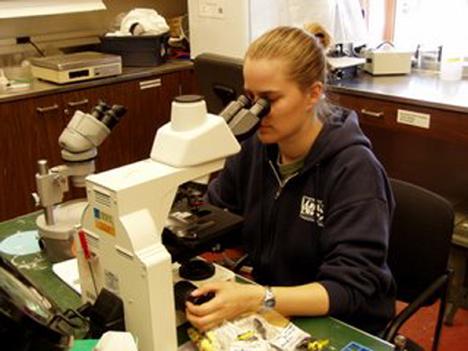How I spent my summer vacation…
July 31, 2006
It’s summer and time for a break from school, work and Champaign. Most college students are planning vacations full of fun while drinking somewhere on a warm, sandy beach with friends, but Nina Hansen is spending her break in Alaska studying caribou.
Hansen, a fourth year student of the veterinary school at the University, is studying 129 caribou to find an average value of the amount of certain enzymes in the animals’ blood cells. She decided to conduct her evaluation of caribou because not a lot is known about them; there aren’t even values that you can look up about them.
For four weeks, Hansen collected samples and data from the caribou. She then brought back the information to a lab on campus to study for three weeks.
“My initial interest was in Alaska,” Hansen said. “There are not a lot of people up there. There is a lot of wilderness and wildlife.”
She had worked with a veterinary graduate from Illinois, Kimberlee Beckman, last summer in the state and found it breathtaking. Hansen said she had enjoyed working with the fascinating animal.
Get The Daily Illini in your inbox!
Although she could have chosen to study any animal, Hansen felt that the caribou should be her choice.
Hansen’s adviser on the project is Petra Volmer, an assistant professor in veterinary medicine at the University. Volmer felt the project was an excellent idea for establishing a missing piece of the puzzle. The caribou population has been declining for years but no one has any idea why this is occurring. By studying the cholinesterase levels in caribou, the project will show whether the animals are being exposed to pesticides.
The project is funded by the Morris Animal Foundation, which gives fellowships to investigators who “study issues and illnesses that affect animals everywhere.” Hansen will attend a conference in June 2007 to present her research along with others who won funding, Volmer said.
While working in Alaska, Hansen also wrote a blog to share her experiences with interested and perspective students. The public relations officer at the veterinary school thought it would be a neat idea to document the project, she said. The posting would help students read about personal experiences others had at the college.
“The blog lets people know what else is out there in veterinary medicine,” Hansen said.
In her blog, Hansen shares information about her findings as well as the people she met and fun times she had.
“At 6:00 a.m. I left for King Salmon,” Hansen wrote in an entry about her trip to do field work. “My flight to Anchorage was uneventful, except for the fact that there were two prisoners onboard. Their hands and legs were shackled and they had a police escort. They sat in the very last seats on the plane, and nobody sat near them (except for their escort and his pistol). They were very quiet though, if not for their “jewelry” and escort, you wouldn’t have been able to tell them from anyone else.”
After her arrival, Hansen waited to be flown to Pumice Creek on the Alaska Peninsula.
“The landscape is really different (for me),” she wrote. “It’s called moist tundra, which basically means a million lakes and no trees. It was pretty crazy to fly over.”
Hansen spent her time on the peninsula tracking calves as well as learning how to play card games and getting to know new people in her area of interest.
“So what would happen is that (other researchers) would go out in the helicopter and find a group of caribou and pick a bull out that was sickly (very skinny, lagging behind, coughing, etc.), and (one of the researchers) would shoot it (in the neck so it would die very quickly),” Hansen wrote. “The two (researchers) would stay with the animal and draw blood and begin measuring and skinning it. The helicopter would come back to camp (which was never very far away) and pick up (another researcher) and I, and bring us to the site to do the necropsy. While (two researchers) and I were doing the necropsies, (another researcher) and the helicopter pilot would butcher the meat so that it could be donated to local villages (where a majority of the people live off of subsistence hunting and fishing).”
Hansen’s particular project dealt with examining the blood from the animals. She takes .5 mL of whole blood from each caribou to do cholinesterase levels on.
Currently, Hansen is vacationing in Alaska for a month before she comes back to reality and the animal lab in Illinois to compile statistics on her data and write papers on her findings for publication.







